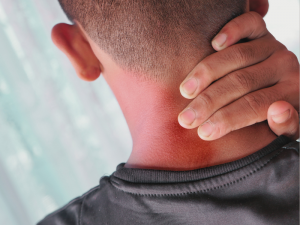Technology in all its forms is an increasingly integral part of daily life. Most adults (and many children) own and regularly use a smart device, and they’re brilliant tools that allow us to work, shop, book holidays, listen to music, read books, watch movies, learn new skills, and catch up with friends and family on the go, wherever we happen to be.
However, the downside is that countless hours spent scrolling through videos of cats in Pilates classes (or whatever your current online screen habit is) have led our bodies to bear the brunt of our repetitive relationship with these beloved devices. Habitually repeating the same movement can result in strain, injury, and pain.
With a high probability that you are reading this article on your smartphone or tablet, ask yourself:
- How are you sitting?
- Where is your head?
- Is your neck ouchy?
Why Neck Pain from Technology is a Bigger Issue Than You Might Realise
The risk of neck pain related to technology usage is a significant issue for many people, yet it’s often overlooked. Holding our heads flexed forward while looking at handheld devices compromises our necks.
Although neck pain connected to excessive-tech usage, especially in children, has been a growing concern, the issue applies just as much to adults who slump or hunch over a laptop or handheld device.
The Science Bit (Well, Sort Of)
Surveys suggest that UK adults touch their phones up to 2,617 times every day! For teenagers, the numbers are even higher, with reports of up to 5,400 times daily, averaging around five hours of tech usage each day. To put this into perspective, most adults touch their faces 2,500 times a day.
Why Is This a Problem?
Using a smartphone or other devices with the neck flexed and head poking forward to view the screen is so familiar that many of us believe it’s ‘normal’, which means we don’t associate the resulting aches and pains with this habitual posture. Awkward positions and technology overuse can lead to tense muscles around the neck, shoulders, and upper back. Over time, this can cause discomfort in the lower back, as well as ankle and foot pain. These sustained postures also put a strain on the joint where the head joins the neck, which can result in headaches.
As an osteopath, I know that for every 2.5 cm, our head pokes forward in front of our neck, it adds an extra 4.5 kg of pressure to the spine — roughly the same weight as a bowling ball! That means most people are carrying around a head that’s double its average weight, which can cause significant strain.
This added weight and force straightens the natural curves of the cervical and thoracic spine, leading to poor alignment. Over time, this head-forward posture can result in muscle strain, disc injury, nerve impingement, and even arthritic changes. In some cases, it also leads to shoulder pain or pain radiating down the arms — a condition known as cervical radiculopathy (or “pinched nerve”).
Symptoms of Neck Pain from Tech Usage
When we habitually hold our head in a flexed and forward position, the curve of the neck can reverse or straighten out. This may cause symptoms such as:
- Neck pain
- Pain between the shoulder blades
- Tense shoulders
- Muscle fatigue
- Headaches
- Tingling or loss of feeling in the hands and fingers
When to Seek Help
If self-help tips don’t improve your symptoms, or if you’re experiencing ongoing pain, it’s time to seek help from your GP or a qualified health professional, such as an osteopath. In most cases, the sooner treatment begins and appropriate lifestyle changes are made, the more likely you are to experience a positive outcome.
Osteopathy and Neck Pain from Technology
Osteopaths are seeing increasing numbers of people with these complaints. My youngest patient with technology-related neck pain is just seven years old, and the oldest is in their late 80s. While I’m happy to use osteopathic (and clinical Pilates) techniques to treat these issues, including manual therapy and corrective exercises, the goal is always to find the root cause of the problem and empower patients to resolve their symptoms.
 Self-Help: Simple Steps to Prevent Neck Pain from Technology
Self-Help: Simple Steps to Prevent Neck Pain from Technology
- For desk-based jobs: Ask for an ergonomics assessment to improve posture.
- For home laptop users: Consider using a laptop stand and a separate keyboard to reduce strain
- Take regular micro-tech-breaks: For every 30 minutes of use, stand up, change positions, or move around. Set a “take a break“ alarm on your phone or wearable device – and use it!
- Improve posture with your smartphone: Raise your device to eye level or use a tablet holder to reduce neck flexion and forward head positioning.
- Switch to a chair with a headrest: This will help prevent forward head posture and encourage you to use your eyes instead of your entire head when looking at screens.
In Summary
Neck pain related to technology usage is a warning sign—whether it’s neck, shoulder, or frequent headaches. Prompt action can reduce or eliminate symptoms and prevent more severe issues from developing.
The simple solution and most significant challenge? Stop looking down and bring your device up in front of your face. Take-home mantra: chin up and lift your breastbone.
Need More Help?
Coming soon: “Pilates to Ease Neck Tension” and a Karma Pilates for Neck Health workshop (open to existing Pilates clients only).
SaveSave
SaveSave
SaveSave
SaveSave
SaveSave
SaveSave
SaveSave
SaveSave
SaveSave
SaveSave









